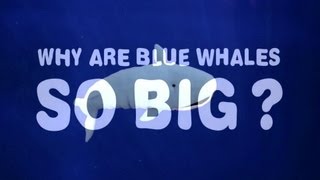(单词翻译:单击)
Blue whales are the largest animals that have ever roamed the planet.
蓝鲸是地球上有史以来出现的最大的动物。
They're at least two times as big as the biggest dinosaurs, "That's big!"
蓝鲸的体型比最大的恐龙至少大两倍,“好大啊!”
the length of a basketball court, and as heavy as 40 African elephants.
身长等同一座篮球场,且重量相当于四十只非洲象。
If that's not enough to make you marvel, here's something that will.
如果这还不够让你惊讶,听听这个。
They're grown to this enormous size by feeding exclusively on tiny shrimp-like creatures called krill that are no bigger than your little finger.
蓝鲸可以只靠食用一种我们称为磷虾的虾状小生物就长得如此巨大,磷虾的体型甚至不及你的小指头呢。
In many ways, the sheer size of krill seems to have driven the evolution of the blue whale.
从很多方面来看,磷虾的大小似乎促使了蓝鲸演化成现在的样貌。
See, krill are so small but are found in dense patches.
磷虾体型虽小,但大量成群出没。
For increased efficiency, blue whales have evolved to use a feeding strategy called lunge feeding.
为了提升效率,蓝鲸演化出一种特殊的觅食策略,叫做“冲刺进食”。
Basically, the whale accelerates towards a prey patch and opens its mouth wide.
基本上,蓝鲸觅食时会加速游向猎物并将嘴巴大大张开。
To increase the capacity, its mouth expands.
为了增加容量,它的嘴巴会不断扩张。
The special, accordion-like blubber layer that extends from its snout to its belly button
从它的鼻尖到肚脐,有一层类似手风琴的特殊结构,
enables the whale to engulf large quantities of prey-laden water.
使蓝鲸可以大口吞入富含猎物的海水。
With each giant gulp, the whale takes in 125% of its body weight in water and krill.
这每一大口,蓝鲸都吞入相当于它体重1.25倍的海水和磷虾。
The whale must then expel the water while retaining the yummy krill.
接着它必须排出吞入的海水,并留住美味的磷虾大餐。
To do this, it uses its baleen, the comb-like structure made of the same stuff our nails and hair are made of, and its tongue.
此时,鲸须便派上用场,鲸须是一种梳子状的构造,成分和我们的指甲及头发一样,它的舌头也同样有所贡献。
It's pretty crazy that the blue whale's heart is as big as a small car,
蓝鲸的心脏跟一台小型车一样大,听起来实在难以置信,
a child could crawl through its arteries, its tongue weighs as much as an elephant,
它的动脉大得足以让小孩在里头爬行,它的舌头跟一只大象一样重,
but its esophagus is so small, the whale could choke on a loaf of bread.
不过它的食管,却小到难以吞咽一条面包。
These whales are really not designed to feed on anything larger than krill.
看起来,蓝鲸还真的不适合吃比磷虾还大的食物。
It's estimated that blue whales eat four tons of krill per day.
据估计,蓝鲸一天可以吃下四吨的磷虾。
Because of the incredible design, each dive provides the blue whale with 90 times as much energy as is used.
因为这种奥妙的构造,蓝鲸每一次进食所获取的能量,为其所消耗的九十倍。
Every mouthful of krill provides almost 480,000 calories, the same amount you get from eating 1,900 hamburgers.
每一口磷虾,蓝鲸都能从中摄取四十八万卡路里,相当于1900个汉堡的热量。

But, why are blue whales so big? Blue whales are considerably larger than the largest living land animal, the elephant.
不过,蓝鲸究竟为何这么巨大?它比陆地上最大的动物--大象,都要大得多。
The heavier an animal is, the greater its relative surface area.
动物越重,它的相对表面积越大。
As weight increases, there's a point at which the legs of that animal would simply collapse.
随着重量的增加,动物的腿会在某一个点承受不住重量,动物就会摔倒在地。
That explains why elephants don't stand on the delicate legs of a horse.
这解释了为什么大象的四肢不像马那样精致。
They need legs shaped like stout pedestals to hold their bodies up against gravity.
大象的脚必须像结实的圆柱,来支撑身体的重量。
In water, the situation is quite different.
在水中,情况则大相径庭。
Buoyancy counteracts the gravitational pull on the body and their great bulk is therefore partially supported by the water.
浮力会抵消地心引力,因此蓝鲸庞大的身躯有一部分是被水的浮力支撑住的。
So, the ocean is a great place for species that want to grow bigger.
因此,对于那些想要长得大一点的动物来说,海洋可以说是一个绝佳的环境。
The other secret to their size is their diet.
蓝鲸这么大的另一原因在于它们的饮食。
By evolving such a huge mouth, the whale's have specialized to catch enormous quantities of highly abundant and nutritious prey,
蓝鲸进化出巨大的嘴,这样它们就能捕食大量供应充足且营养丰富的食物,
which provides the energy needed to grow so big.
获取的能量使它们能够长这么大。
But, now maybe you're wondering why blue whales aren't any bigger?
但是现在,也许你在疑惑为什么蓝鲸不长得更大一些?
After all, the ocean sounds like nirvana for any growing beast.
毕竟,海洋听起来就像是庞然大物的天堂。
Well, while lunge feeding may have allowed blue whales to become the biggest animal to have ever roamed the planet,
原因在于,尽管靠冲刺进食法能够让蓝鲸成为出现在地球上的最大的动物,
by enabling them to feed efficiently in dense prey patches, it isn't cost free.
但这样高效率的进食模式并非没有代价。
Scientists compared all the costs involved with lunge feeding to the energy gained from the krill they eat.
科学家将冲刺进食法的所有消耗与从磷虾身上获得的能量做了比较。
What they found is that when the whale's body increases in size,
他们发现蓝鲸随着体型增长,
the energy that body demands rises faster than the extra energy they get from their food.
身体所需能量的成长速度远超过食物来源所能提供的量。
Feeding whales needs 15 times the energy required to remain still and 5 times more energy than used when swimming.
进食需要的能量是静止不动时的15倍,游泳时的5倍。
Calculations show that the largest a lunge feeder can grow is 33 meters, pretty much blue whale size.
经计算,使用冲刺进食法的动物最多能长到33米,蓝鲸差不多就是这么大。
Turns out blue whales have a lot to thank krill for:
看起来蓝鲸应该多多感谢磷虾:
neat, evolutionary adaptations that would not have been possible if krill were not so small.
若非磷虾这么小,蓝鲸是不可能顺利进化,也无法适应生存环境的。
It's incredible that these tiny creatures have allowed blue whales to really push the limits of size on our planet.
这些小生物竟然能让蓝鲸的体积达到地球上动物的极限,着实令人惊叹。
Makes you wonder if that old adage, "You are what you eat," really does apply in blue whale world.
不禁使人怀疑,“人如其食”这句俗语似乎不适用在蓝鲸身上。


